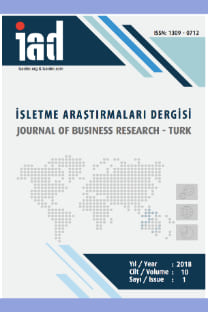Roles of the Jumps in Foreign Exchange Markets: A comparative Analysis of Non-Parametric Jump Tests
Roles of the Jumps in Foreign Exchange Markets: A comparative Analysis of Non-Parametric Jump Tests
___
- Aït-Sahalia, Y., & Jacod, J. (2009). Testing for jumps in a discretely observed process. The Annals of Statistics, 184-222.
- Andersen, J. V. (2010). Detecting anchoring in financial markets. Journal of Behavioral Finance, 11(2), 129-133.
- Andersen, T. G., Bollerslev, T., & Diebold, F. X. (2007). Roughing it up: Including jump components in the measurement, modeling, and forecasting of return volatility. The review of economics and statistics, 89(4), 701-720.
- Andersen, T. G., Bollerslev, T., & Dobrev, D. (2007). No-arbitrage semi-martingale restrictions for continuoustime volatility models subject to leverage effects, jumps and iid noise: Theory and testable distributional implications. Journal of Econometrics, 138(1), 125-180.
- Andersen, T. G., Dobrev, D., & Schaumburg, E. (2012). Jump-robust volatility estimation using nearest neighbor truncation. Journal of Econometrics, 169(1), 75-93.
- Andersen, T., G., Bollerslev, T.(1998). Deutsche Mark – Dollar Volatility : Intraday Activity Patterns , Macroeconomic Announcements, Journal of Finance, 53 (1), 219-265
- Balduzzi, P., Elton, E. J., & Green, T. C. (2001). Economic news and bond prices: Evidence from the US Treasury market. Journal of financial and Quantitative analysis, 36(4), 523-543.
- Barndorff-Nielsen, O. E., & Shephard, N. (2004). Power and bipower variation with stochastic volatility and jumps. Journal of financial econometrics, 2(1), 1-37.
- Barndorff-Nielsen, O. E., & Shephard, N. (2006). Econometrics of testing for jumps in financial economics using bipower variation. Journal of financial Econometrics, 4(1), 1-30.
- Basseville, M., & Nikiforov, I. V. (1993). Detection of abrupt changes: theory and application (Vol. 104). Englewood Cliffs: Prentice Hall.
- Bollerslev, T., Law, T. H., & Tauchen, G. (2008). Risk, jumps, and diversification. Journal of Econometrics, 144(1), 234-256.
- Bollerslev, T., Todorov,V.,Li, Z.,S.(2013) . Jump tails, extreme dependencies, and the distribution of stock returns.Journal of Econometrics, 172, 307-324.
- Cont, R., Tankov, P. (2004). Financial Modelling with Jump Processes, second printing. Chapman and Hall/CRC Press, London
- Corsi, F., Pirino, D., & Reno, R. (2010). Threshold bipower variation and the impact of jumps on volatility forecasting. Journal of Econometrics, 159(2), 276-288.
- Dewachter, H., Erdemlioğlu, D., Gnabo, Y., J. & Lecourt, C. (2014). The Intra-Day Impact of Communication on Euro-Dollar Volatility and Jumps. Journal of International Money and Finance.
- El Ouadghiri, I., & Uctum, R. (2016). Jumps in equilibrium prices and asymmetric news in foreign exchange markets. Economic Modelling, 54, 218-234.
- Jiang, J.,G.,Oomen, C.A.,R. (2008)Testing for Jumps When Asset Prices Are Observed with Noise—A “Swap Variance” Approach. Journal of Econometrics, 1444 (2), 352-370
- Lahaye, J., Laurent, S., & Neely, C. J. (2011). Jumps, cojumps and macro announcements. Journal of Applied Econometrics, 26(6), 893-921.
- Lee, S. S., & Mykland, P. A. (2008). Jumps in financial markets: A new non-parametric test and jump dynamics. The Review of Financial Studies, 21(6), 2535-2563.
- Lee, S., & Mykland, P. A. (2012). Jumps in equilibrium prices and market microstructure noise. Journal of Econometrics, 168, 396-406.
- Maheu, J.,M., Mccurdy, H.,T.(2004). News Arrival, Jump Dynamics, and Volatility Components for Individual Stock Returns. The Journal of Finance. 2. 755-793
- Merton, R. (1976). Option pricing when underlying stock returns are discontinuous. Journal of Financial Economics.
- Palmes, C., & Woerner, J. H. (2013). The Gumbel test for jumps in stochastic volatility models.
- Qiu, P., & Yandell, B. (1998). Local polynomial jump-detection algorithm in non-parametric regression. Technometrics, 40(2), 141-152.
- Schwert, G. W. (2011). Stock volatility during the recent financial crisis. European Financial Management, 17(5), 789-805.
- Shiau, J. J. (1986). Smoothing spline estimation of functions with discontinuities. Dissertation Abstracts International Part B: Science and Engineering[DISS. ABST. INT. PT. B- SCI. & ENG.],, 46(11).
- Tauchen, G., & Zhou, H. (2011). Realized jumps on financial markets and predicting credit spreads. Journal of Econometrics, 160(1), 102-118.
- Wang, Y. (1995). Jump and sharp cusp detection by wavelets. Biometrika, 82(2), 385-397.
- Wong, H., Ip, W., & Li, Y. (2001). Detection of jumps by wavelets in a heteroscedastic autoregressive model. Statistics & probability letters, 52(4), 365-372.
- Yin, Y. Q. (1988). Detection of the number, locations and magnitudes of jumps. Communications in Statistics. Stochastic Models, 4(3), 445-455.
- Zhu, S. C. (1999). Stochastic jump-diffusion process for computing medial axes in Markov random fields. IEEE Transactions on Pattern Analysis and Machine Intelligence, 21(11), 1158-1169.
- Zoi, P.(2017). Price and Volatility Jumps in the Stock Markets, PhD Thesis, Department of Economics Ca’ Foscari University of Venice.
- Zoi, P., Ferriani, F.(2017). The Dynamics of Price Jumps in the Stock Market: an Empirical Study on Europe and U.S. Paris December 2017 Finance Meeting EUROFIDAI - AFFI
- ISSN: 1309-0712
- Yayın Aralığı: 4
- Başlangıç: 2009
- Yayıncı: Melih Topaloğlu
An Investigation of Employee Performance Differences between Native and Immigrant Employees
Şule ERDEM TUZLUKAYA, Emad Anver ALBAYATI
Dönüştürücü Liderlik Algısının İş Performansına Etkisinde İçsel Motivasyonun Aracı Rolü
Diyarbakır İli İmalat Sanayinin Mevcut Durum Analizi
Mustafa BULUT, Hasan BAYINDIR, Abdulkadir SAKA, Aziz Mahmut YÜCELEN
Roles of the Jumps in Foreign Exchange Markets: A comparative Analysis of Non-Parametric Jump Tests
Bilişim Teknolojileri - İş Uyumlamasi İçin Gerekli Örgütsel Faktörler
Çok Kriterli Karar Verme Yöntemleriyle Otogar Lokasyon Seçimi: İstanbul İli Örneği
Uğur Orhan KARAKÖPRÜ, Hazar DÖRDÜNCÜ, Barış Erkan YAZICI
Lojistik Faaliyetlerde Antrepoların Etkinliğinin Veri Zarflama Analizi ile Belirlenmesi
The Effect of Corporate Governance Mechanisms on Banks Performance Using GLS: The Case From Kenya
Nahifa Said SOUD, Nevzat AYPEK
Yiyecek İçecek İşletmelerinde Nomofobinin İşgören Verimliliğine Etkisi
